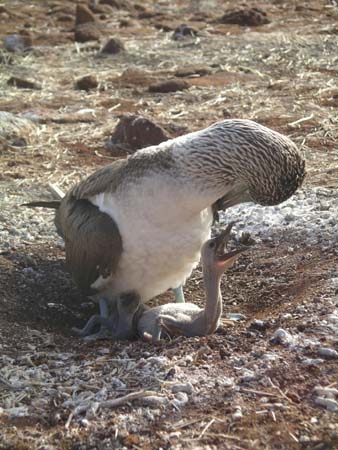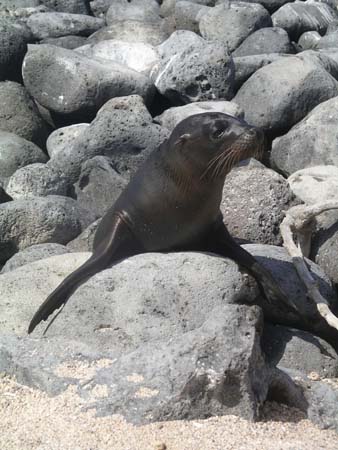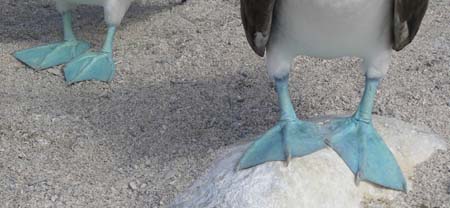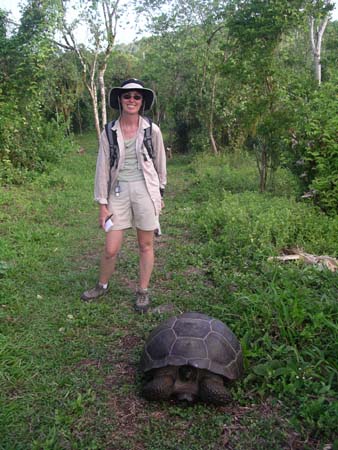Tuesday, April 27
Paula and Steve: Our last full day in the Galapagos Islands was busy and exhilarating, with an itinerary that included hiking and snorkeling. Our time was spent in the central part of the archipelago on Santa Cruz and North Seymour Islands.
In the morning we hiked for several hours on North Seymour Island which is only 90 feet above sea level and relatively flat. Frigate birds, swallow-tailed gulls and blue-footed boobies were the highlights here. Although we had seen all these birds on previous days, we continue to be amazed by their tameness and highly entertaining behaviors.
 We
were the first group to arrive on the island, and as we pulled up in the zodiac
we saw several sea lions lining the dock making it very difficult to disembark.
We literally had to step over several moms and th
We
were the first group to arrive on the island, and as we pulled up in the zodiac
we saw several sea lions lining the dock making it very difficult to disembark.
We literally had to step over several moms and th eir
pups to get on to the island. Although this seems to be the case everywhere
we go, it still seems amazing to see these wonderfully expressive sea lions
unafraid and relaxing and playing so close to us. It was also here by the
dock that we saw a swallow-tailed gull (pictured above) sitting on a beautiful
brown speckled egg.
eir
pups to get on to the island. Although this seems to be the case everywhere
we go, it still seems amazing to see these wonderfully expressive sea lions
unafraid and relaxing and playing so close to us. It was also here by the
dock that we saw a swallow-tailed gull (pictured above) sitting on a beautiful
brown speckled egg.
 Our
expectation for our time on North Seymour Island was that we'd primarily be
seeing sights similar to those earlier in the week on Espanola and Genovesa
Islands, since the main attraction here are the boobies and frigate birds.
However, we soon realized that we were in for a very different treat, especially
regard to the blue-footed boobies. Here on North Seymour it was possible to
see scores of these birds sitting on nests, caring for their eggs and tending
to their newborn chicks. What a
Our
expectation for our time on North Seymour Island was that we'd primarily be
seeing sights similar to those earlier in the week on Espanola and Genovesa
Islands, since the main attraction here are the boobies and frigate birds.
However, we soon realized that we were in for a very different treat, especially
regard to the blue-footed boobies. Here on North Seymour it was possible to
see scores of these birds sitting on nests, caring for their eggs and tending
to their newborn chicks. What a  fantastic
sight this was!
fantastic
sight this was!
As we walked on the inland part of the trail, we quickly discovered hundreds
of the blue-footed boobies. As was the case on Espanola Island, many were
in couples performing their courtship routines, complete wi th
honking, whistling, dancing, pointing, and the offering of twigs as gifts.
Many of these unique birds were actually nesting on the ground, often right
by the trail. Our naturalist explained that they were keeping their eggs warm,
and sure enough with a bit of patience, we observed a booby rise slightly
off the nest and use her beak to rearrange the eggs so that the heat was evenly
distributed for successful incu
th
honking, whistling, dancing, pointing, and the offering of twigs as gifts.
Many of these unique birds were actually nesting on the ground, often right
by the trail. Our naturalist explained that they were keeping their eggs warm,
and sure enough with a bit of patience, we observed a booby rise slightly
off the nest and use her beak to rearrange the eggs so that the heat was evenly
distributed for successful incu bation.
bation.
Before long, we discovered another booby with egg shells lying next to her.
Our naturalist was convinced that the chicks had already hatched and were
underneath the adult (males and females take turns sitting on the eggs and
chicks). We waited and after just a few minutes, we saw two chicks peak  out
from under their parent. First all we could see were the beaks, but then we
stayed hoping for a better view, and were rewarded when the mother stood up
to reveal the full faces on these tiny birds (probably only 2-3 days old).
One of the chicks extended its neck and opened its mouth wide open looking
for food. We all stood watching for several minutes (taking many, many
out
from under their parent. First all we could see were the beaks, but then we
stayed hoping for a better view, and were rewarded when the mother stood up
to reveal the full faces on these tiny birds (probably only 2-3 days old).
One of the chicks extended its neck and opened its mouth wide open looking
for food. We all stood watching for several minutes (taking many, many pictures!) at this fantastic sight. The amazing thing again was how close
we were able to get to these birds.
pictures!) at this fantastic sight. The amazing thing again was how close
we were able to get to these birds.
We then continued our walk along the trail, observing more nesting boobies. Their nests are not made of any special materials - the birds essentially lay their eggs right on top of the dirt. They actually mark the area of the nests by encircling them with droppings. The boobies can lay up to three eggs, and they can be either white, light blue or black speckled in color. Just when we thought we had seen everything (courtship dances, incubating eggs and newborn chicks), we caught a glimpse of two boobies mating. This is actually somewhat unusual, because our naturalist told us that the mating dance takes up to three hours, but that the actual mating is over in an "instant"!
 Finally,
to top it all off, Katie noticed a female that looked particularly fat. The
naturalist agreed, and our whole group knelt down and witnessed the exact
moment that the bird layed her egg. David even got a picture of the egg just
before it came out! Our naturalist was astonished and told us that in 12 years
of guiding here in the Galapagos Islands, she had NEVER seen this before (she
even insisted that we send her a copy of our picture). David and Katie felt
justifiably special about this whole experience.
Finally,
to top it all off, Katie noticed a female that looked particularly fat. The
naturalist agreed, and our whole group knelt down and witnessed the exact
moment that the bird layed her egg. David even got a picture of the egg just
before it came out! Our naturalist was astonished and told us that in 12 years
of guiding here in the Galapagos Islands, she had NEVER seen this before (she
even insisted that we send her a copy of our picture). David and Katie felt
justifiably special about this whole experience.
Our time on North Seymour became a complete success after we found two land iguanas (David actually was responsible for spotting one of the two on behalf of our group). These endemic iguanas are much more difficult to see in the Galapagos because they usually stay in the uninhabited highlands where visitors are not allowed. They were hunted almost to the point of extinction, and great efforts have been made to help recover their once-thriving population. We had been told that there are only 47 of these iguanas on North Seymour, so we felt quite fortunate to have seen two of these interesting creatures during our relatively short hike.
We learned that the land iguana, like most reptiles, has poor vision and hearing but uses its tongue to collect information about its environment - the information is then interpreted by a special gland in behind the ear. Scientists sometimes call this the iguana's "sixth sense". The land iguana has no teeth and we had fun watching them chomp on the local vegetation.





Our eventful hike was followed by a wonderfully exciting snorkel. We knew that this would be our last opportunity to snorkel here, and jumped off the zodiac with high hopes and expectations. The water was noticeably warmer and calmer, which was already a big improvement over yesterday's experience.
Within seconds we were totally surrounded by a family of playful sea lions. As we snorkeled along the rocky shoreline, the sea lions escorted us and obviously had fun frolicking and showing off all around us. At one point, we found ourselves in the midst of at least 12-15 of these fun loving mammals! Their favorite trick was to swim full-speed directly at our masks, veering away only at the last instant as they blew bubbles in our faces. The pups especially enjoyed this, and circled around again and again to swim at one of us and then the other. Each one would do the exact same thing - swim directly at us, almost waiting for us to flinch, and then dive quickly below just before hitting our masks. It was absolutely incredible.
The number of sea lions grew as we proceeded along the shore and by the
time our guide called us into the boat, we were swimming with a large colony
these fun-loving mammals. During our prior snorkels, the pups seemed the most
curious but today we found ourselves swimming with pups, adult females and
even a huge bull (he appeared absolutely huge in the water but didn't seem
bothered at all by our presence). They accompanied us to the edge of the zodiac
and popped their heads out of the water as we climbed up the ladder as if
to say goodbye. T hey
really seemed to be pleading for us to stay and play!
hey
really seemed to be pleading for us to stay and play!
Our snorkel also provided great views of many colorful fish along with a large stingray, but none of this compared with our experience with the sea lions. Paula was particularly happy not to encounter any of the sharks that we understand frequent these waters (including hammerheads). This was our last snorkel in the Galapagos and certainly one we will never forget.
During lunch our ship cruised to Santa Cruz Island. At the dock, we enjoyed
watching large groups of boobies dive into the ocean in rapid succession at
the small fish along the shore. These birds are excellent divers and have
special membranes over their eyes and noses that close for protection just
before the birds hit the water. The frigate birds actually depend on the boobies
for much of their food. We actually saw the frigates gang up on boobies as
they were fishing, trying to steal their catch.
Our trip to the highlands of Santa Cruz was in search of the famous Galapagos
tortoises. While we had seen some of these interesting animals at the Darwin
Center earlier in the week, this was our first chance to see them in the wild
and roaming fre ely.
Santa Cruz Island has about 3,500 tortoises and we were happy to find 12 of
these amazing creatures during our hike this afternoon.
ely.
Santa Cruz Island has about 3,500 tortoises and we were happy to find 12 of
these amazing creatures during our hike this afternoon.
Slow moving and somewhat shy, the tortoises often hide in their shells once
discovered. They also make a hissing noise that indicates nervousness. These
vegetarians were hunted in the past by whalers and pirates because they are
able to live up to one year without food or water (unfortunately they were
kept upside down in the holds of the ships). These tortoises provided fresh
meat to sailors on  long
expeditions.
long
expeditions.
There are 15,000 of these amazing animals remaining today, and they are now
fully protected - in fact there are only a few islands where visitors are
allowed to view them. The oldest tortoise on Santa Cruz Island has lived for
120  years,
and the oldest recorded specimen in the Galapagos died at age 180. The rings
on their shells can be used to roughly determine age. This afternoon we observed
their beautiful doom-shaped shells and admired the larger males as well as
several juveniles and smaller females.
years,
and the oldest recorded specimen in the Galapagos died at age 180. The rings
on their shells can be used to roughly determine age. This afternoon we observed
their beautiful doom-shaped shells and admired the larger males as well as
several juveniles and smaller females.
On the way back to the ship, we stopped to view two huge collapsed volcanic craters formed about 500 years ago. We also noticed that our driver had to honk at the small birds along the road to avoid hitting them. This again reminded us of how tame (or perhaps naïve) the wildlife is on the Galapagos. It also made us reflect on the importance of preserving their habitat and way of life.
We are all sad to see this part of our adventure end, but leave with wonderful memories and a new appreciation for our dynamic planet and all of its creatures. Tomorrow we leave from San Cristobal and fly back to Quito in the afternoon.

These are some more of the best pictures that David took today...
.jpg)
.jpg)
.jpg)
.jpg)
.jpg)
.jpg)

David's Daily Dump: Evolution of Flightless Cormorants. Yesterday we saw one of the best examples of evolution on the Galapagos Islands: The Flightless Cormorants. Scientists believe that their ancestors (who could fly) landed on the archipelago millions of years ago, and slowly they have evolved to become great swimmers. No one knows exactly why they have evolved, but most people think that it was because of the water temperature, or where their prey was located. These are fascinating birds that I had been looking forward to seeing from the very beginning.
The first time we saw this amazing and mysterious bird was on our dingy ride around Fernandina Island. From the back of the boat, we saw a little black head poke up from the surface and then immediately dive down again. We then motored along the volcanic rocks and came across many pairs drying their wings and picking at their feathers.
 I
was fascinated with their wings which were ugly, short, stubby, and almost
bald (the wings had very few feathers on them). These wings are prime examples
of evolution and natural selection. Millions of years ago, these wings were
probably long and very well suited for flight. Now you can clearly see that
these wings could never lift anything off the ground. This puzzled me, and
I tried to think of something that would have diverted the cormorants from
flying. No matter how I looked at the situation, it always looked like flight
was a good thing. You can search for fish unnoticed in the air, and easily
escape land predators. Although our guide gave us some answers, nothing seemed
right in my mind. Her opinion was that since there was an abundance of fish
right next to their nesting site they didn't have to fly to reach their fishing
grounds. Their ancestors used to dive from the air like boobies, and catch
their prey underwater. Now the Flightless Cormorants swim underwater, and
supposedly don't use their wings at all. They just kick with their powerful
feet to propel them through the water. Maybe the water was warmer than where
they used to fish, so they didn't need layers of feather (on their wings)
to keep them warm.
I
was fascinated with their wings which were ugly, short, stubby, and almost
bald (the wings had very few feathers on them). These wings are prime examples
of evolution and natural selection. Millions of years ago, these wings were
probably long and very well suited for flight. Now you can clearly see that
these wings could never lift anything off the ground. This puzzled me, and
I tried to think of something that would have diverted the cormorants from
flying. No matter how I looked at the situation, it always looked like flight
was a good thing. You can search for fish unnoticed in the air, and easily
escape land predators. Although our guide gave us some answers, nothing seemed
right in my mind. Her opinion was that since there was an abundance of fish
right next to their nesting site they didn't have to fly to reach their fishing
grounds. Their ancestors used to dive from the air like boobies, and catch
their prey underwater. Now the Flightless Cormorants swim underwater, and
supposedly don't use their wings at all. They just kick with their powerful
feet to propel them through the water. Maybe the water was warmer than where
they used to fish, so they didn't need layers of feather (on their wings)
to keep them warm.
At first I though that maybe they lost the ability to fly because there were
no predators around, so they didn't ever need to worry about escaping. But
this wouldn't make sense because they do have predators: hawks, snakes, owls,
rats (eat eggs), and introduced mammals. Then I thought maybe it's because
the land predators would not be able to get them if they were in the water
most of the time. But this wouldn't make sense because they have to worry
about sharks and sometimes sea lions. No matter what ideas I had, they didn't
seem to work. It was fun guessing though!
Over the past couple of days, I have found myself paying attention to everything
we learn about evolution and natural selection. In fact, I think that I am
beginning to love biology and marine biology. Who knows, maybe I'll major
in it, all because of the Flightless Cormorant!
